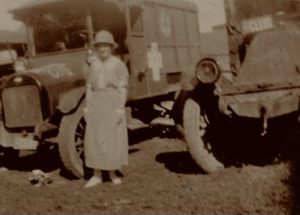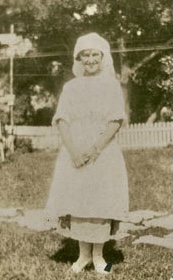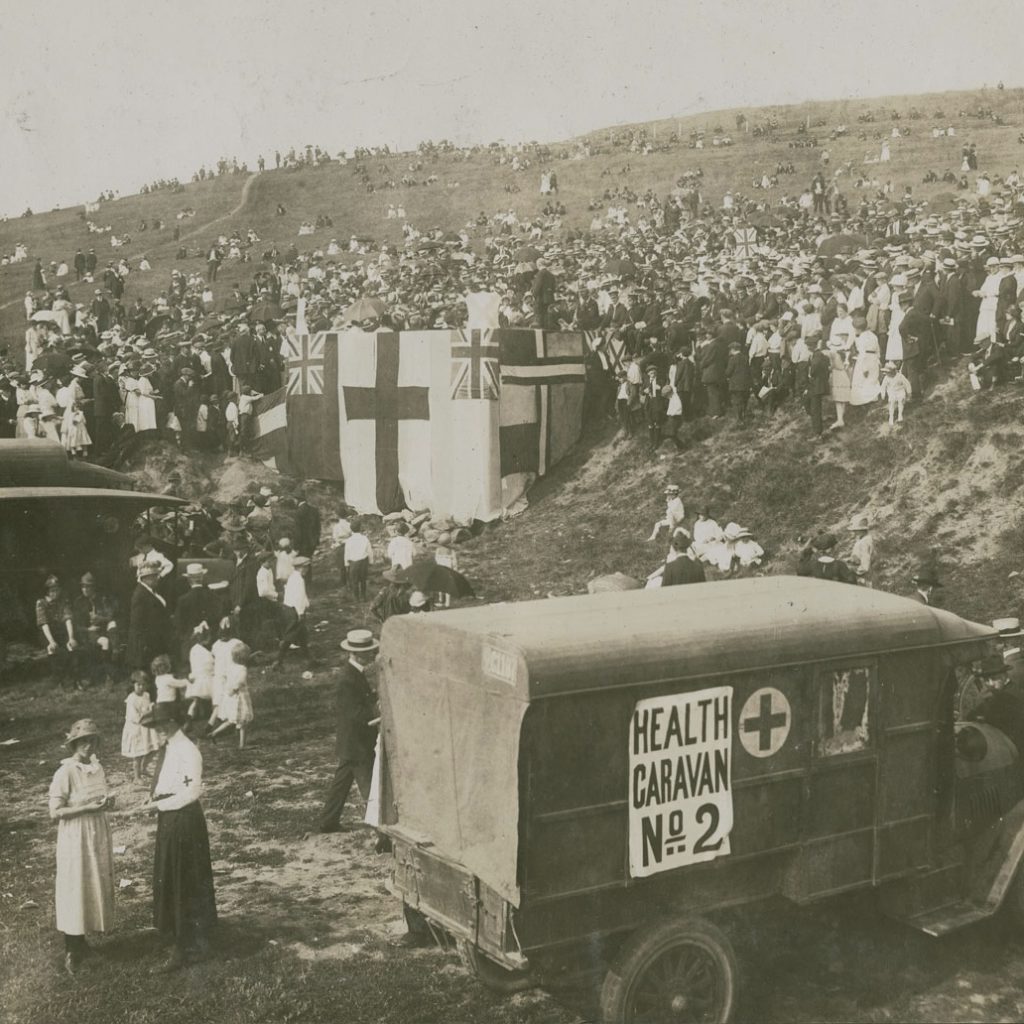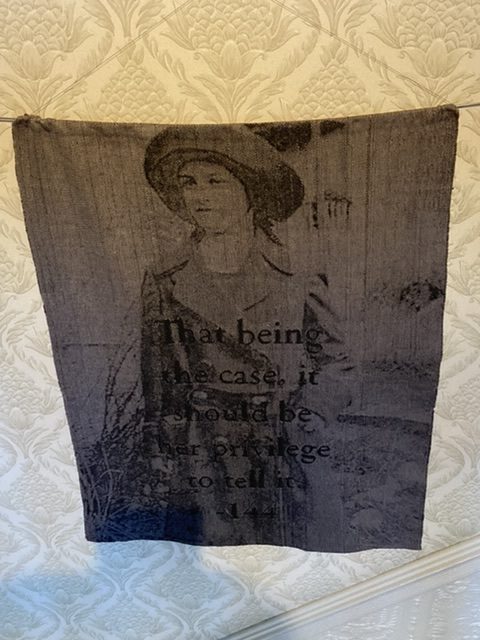Personal Story #5
As a child, sometimes it’s the simplest of memories that is remembered and this memory of Helen’s from approximately 1903 is about her father, Charles, that takes place in Dartmouth.
“ I was born in a double house [side by side attached] on Portland Street, facing Hawthorne. Everybody was born at home in those days. Hawthorne was a short street with woods between the school and the next parallel street. I can remember coming home from a picnic one night when I was no more than four and having to climb a steep bank on Prince Albert Road to reach a path through the woods.But I was not afraid of the dark, for wasn’t one small hand clasped in my father’s while he carried a lantern in the other.”
~ A Life in Folklore by Helen Creighton
Photo: Alice (mother), Helen Creighton, Charles (father)
https://archives.novascotia.ca/creighton/archives/?ID=296
Personal Story #4
Helen the Wonder Woman!
Dr. Helen Creighton followed her dreams and accomplished many things in her lifetime (1899-1989).
While in her teens and twenties, Helen:
- Graduated from Halifax Ladies College on 1916.
- Survived the Halifax Explosion and drove the injured and wounded of Dartmouth to medical care.
- Chauffeured Officers for the Royal Flying Corp in Toronto, at the age of 19.
- Drove a truck for the Red Cross Caravan that provided medical services to the rural areas of Nova Scotia in the summer of 1920.
- Attended The University of Toronto and started a Social Services Course and later volunteered at the Halifax Infants Home.
- Taught at the American School in Guadalajara for the daughters of Mexican and foreign parents.
- Wrote articles about her experiences and observations in a foreign land for MacLeans magazine.
- Read stories for CHNS radio, Halifax, under the name, Aunt Helen. She chose the show’s music and wrote all of the dialogue.
- Joined the Canadian Authors Association in 1926. By the 1930’s, the majority of authors were women.
- Moved to Ottawa and wrote stories about Nova Scotia for leading Canadian publishers including the Toronto newspaper, Saturday Night.
- Returned to Dartmouth, became interested in folk music and started collecting her first material at Hartlan’s Point, Eastern Passage from Enos Hartlan in 1928.
From 1928 onwards, Helen travelled the Maritimes (with a focus on Nova Scotia) collecting stories, songs and folklore and recording hundreds of people from many communities and cultures.
At that time, there were limited folklore courses and instruction so she relied on her connections with others in the folklore field to help her out when necessary but she was basically self taught. She had to figure out how to find new material, how to interview, how to build trust with the wives of her male informants and how to encourage people to sing or tell to a stranger and a woman.
In addition, Helen had to learn to operate various kinds of recording machines over the years often doing her own troubleshooting. She had to address the nervousness of her informants during the recording session as most people had never seen recording machines or listened to recordings of their own voices.
Into the 1980’s, Helen Creighton collected thousands of songs, stories, superstitions, folklore, including a few games, dances, and folk crafts. Her collection resides in the Nova Scotia Archives, as well as, the Smithsonian in the US and the Museum of History in Canada. Her former home, Evergreen, is now the Dartmouth Heritage Museum and features a permanent Helen Creighton exhibit. Over the years, she received many awards and accolades for her accomplishments including the Order of Canada.
Helen was a woman working in a time when women were struggling for women’s rights, facing many changes in society, working through two world wars, and adapting to many struggles and challenges for women.
She helped people whenever possible and cared greatly for her family, friends and her informants (some became friends). She tried new things and succeeded or excelled at them but she also made mistakes and learned from them.
Most impressively, Helen followed her dream of becoming a writer.
Personal Story #3
Helen Survives the Halifax Explosion
Helen Creighton was 18 years old on December 6, 1917. At 9am she was lying in bed asleep when a loud noise jolted her awake. She sat up in bed and looked out the window to see a large fireball in the sky over Halifax. A voice in her head told her to move quickly. She dove under the covers at the foot of the bed moments after a munitions ship, the Mount Blanc, exploded in Halifax Harbour. The four windows in her bedroom crashed inwards and a piece of the window casing with nails was imbedded in the pillow where Helen’s head had just been resting.
The entire household ran to the basement believing the German’s had attacked Halifax. They waited anxiously for more explosions or sounds of bombing but when nothing else happened, everyone made their way up from the basement. Even though, they had run in bare feet over broken glass, the only injury was a slight cut over the eye of Helen’s mother, Alice. The rest of the house sustained a bit of damage: falling plaster, broken windows and broken chimneys, and tiny bits of glass ended in the walls and pictures hanging in frames, but no major structural damage.
After consulting with her worried mother, Helen and her friend, Doris, went to look for her father. Charles had left for work in Halifax that morning and would have been on board the Dartmouth Ferry just before 9am. When she arrived at the Dartmouth waterfront a few streets from her house, she was relieved to see the ferry had survived the explosion and was still running. She crossed and went to his office on Bedford Row in Halifax and discovered he had gone to Citadel Hill to assist. He had been on the ferry when the explosion happened and was knocked to his knees between two horses. When she heard Charles was unharmed, she quickly made her way home.
Helen saw incredible sights of collapsed and burning buildings, wreckage along the shore, people dead or injured and bleeding. Some people lost their eyesight because of shattered glass. Others would live the rest of their lives with glass embedded under their skin.
Helen knew she had to help and so she hopped into the family car and for the rest of the day she drove people to places to get medical help. On her next trip on the ferry, she met her brother, Syd, who had been stationed with a company of engineers on McNabs Island at the mouth of the harbour and were on their way to Halifax to assist with the relief efforts. Helen was thankful he was okay.
She slowly learned the reason for the explosion which was not an attack by Germans, but the collision of two ships: the Belgian Relief ship, Imo, and the munitions ship, Mont Blanc. The Mont Blanc was overloaded with explosives for the war overseas. The impact caused a fire which spread quickly resulted in the largest man made explosion at that time.
Later that night, a blizzard hit Halifax and covered the horrors in a blanket of white which made rescue efforts very difficult. The next day Helen went to Halifax City Hall and helped organize clothing drives and deliver supplies.
At one point, someone handed her a broadside sheet with a song called, Halifax In Ruins. The song was gruesome in its descriptions and so Helen didn’t keep it as she was too traumatized. Later in life, as a folklorist, Helen regretted not spending the ten cents to purchase that piece of paper.
The Halifax Explosion was an experience, Helen would never forget.
Personal Story #2
What was Helen Creighton doing 100 years ago?
Helen had just turned 20 years old in 1920 when her family moved from their home on Portland Street in Dartmouth to Evergreen House at 26 Newcastle Street. The house was named for a grove of evergreen trees that once surrounded the premises.
Helen was planning on enjoying the summer in her new home when she was asked to drive an ambulance for the Red Cross. There were surplus monies from the Halifax Relief Fund and the Red Cross was organizing a medical caravan to travel the rural areas and offer free medical assistance. Helen had previous experience driving a truck during the war years. At first she wasn’t going to accept the job but somehow her name appeared in the morning paper with a mention of a young women who would be driving an ambulance, Miss Helen Creighton.
So, Helen became an ambulance driver and travelled the roads of Nova Scotia with a medical team. She sometimes assisted during minor procedures such as tooth extractions and tonsil removal operations.
The caravan travelled to Baddeck, Cape Breton where Helen saw Alexander Graham Bell’s water flying boat aka the Hyrofoil which was at the time, the fastest boat in the world. When the caravan returned to Halifax at the end of the summer, there was a huge celebration at the bottom of Citadel Hill. It certainly was a different summer from what she had planned!



Personal Story #1
Helen Creighton was born on Sept 5, 1899 in Dartmouth, Nova Scotia.
She was born with a caul over her face. A caul is a piece of the placenta from the mothers womb. In many cultures, a caul brings good fortune if it is protected and kept near the person for all of their life.
The Doctor gently removed the caul from Helen’s face and placed it on a piece of foolscap paper and gave it to her mother for safe keeping. The caul was kept for Helen and was at one time stored in a file cabinet in her home at Evergreen. The caul was cremated with Helen upon her death. Helen died at the age of 90 on December 12, 1989.
Personal stories written by Cindy Campbell-Stone, HCFS.
Resources:
- Helen Creighton-Canada’s First Lady of Folklore by Clary Croft, Nimbus Publications, Halifax, NS, 1999.
- A Life in Folklore. [Autobiography] by Helen Creighton, Toronto and New York: McGraw-Hill Ryerson, 1975.
- Photos from the Nova Scotia Archives, Helen Creighton Collection; or directly from the Creighton family; or by Cindy Campbell-Stone


Jessie Fraser, artist, celebrating Helen with an art exhibit at the Dartmouth Heritage Museum.

